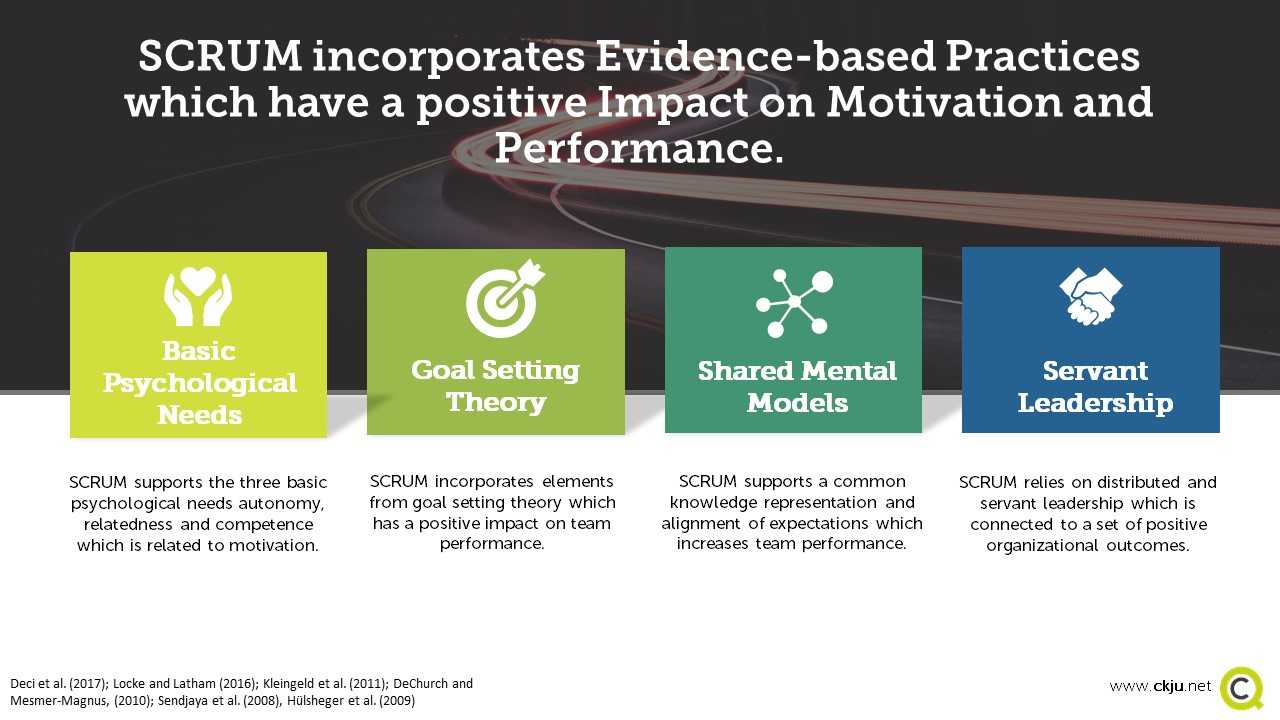- Blog
- Agility, agile frameworks and SCRUM
Contents
- 'Agility' is a popular term in business. However, what is behind the idea is rarely addressed.
- The practical application of agility in the real world has its origins in the military.
- Agility is about gaining a competitive advantage through a superior decision-making process and accelerated learning.
- SCRUM is framework that provides guidance on how to conduct agile projects.
- SCRUM is a team-based approach that has a positive impact on motivation.
- SCRUM incorporates elements from goal setting theory, which has a positive impact on team performance.
- SCRUM supports a common knowledge representation and alignment of expectations, which increases team performance.
- SCRUM relies on distributed and servant leadership which is connected to a set of positive organizational outcomes.
- Agility and agile frameworks such as SCRUM do indeed add value.
- Agility is more than SCRUM and Kanban
- References and further reading
Agility is about gaining a competitive advantage through a superior decision making process in terms of decision making speed, quality, implementation and learning from (side-) effects.
'Agility' is a popular term in business. However, what is behind the idea is rarely addressed.
The term 'agility' in all its different shapes and flavours has made its way into almost every organization. From product development to marketing and even as framework in the area of learning and development - everybody is talking about agility. However, the fundamental concept behind it is usually not addressed or just taken for granted. This is an issue especially when you not just want to adapt what other organizations do, but when you want to get most out of it for your specific case and context.
The practical application of agility in the real world has its origins in the military.
While agility has only recently found its way into the business domain, it has been around for a long time as decision making framework in the military. However, it was never called agility, but applies the principles that constitute the core of agility. One of the first publications that applies those principles goes back to ancient Chinese military strategist Sun Tzu. In his book “The Art of War” he emphasizes the need for being one step ahead of your adversary in your decision making cycle in order to succeed.
A more contemporary application of the principles behind agility is the mission-command military tactics approach, which has been widely used by different armies since the 19th century (Wittmann 2017). In business terms, mission command can be best explained as similar to the management by objectives leadership style. However, there is one important difference. Mission-command is implemented in form of frequent decision cycles, which are triggered by a commander who is located at the point of action. He observes the unfolding of events more or less in real time. On a regular basis and as soon as any important variable such as weather, terrain, own or enemy position takes a turn, the commander initiates a new decision cycle following a pre-defined scheme. Results are translated into new orders and communicated to his units which go through a similar decision making cycle.
Management skills newsletter
Join our monthly newsletter to receive management tips, tricks and insights directly into your inbox!
Jon Boyd, a US military strategist who was involved in the development of new generation of fighter aircraft, took a more formal approach to agility. He argued that agility is the ability of any living organism to perceive changes of its environment, make sense of it, take appropriate decisions and translate them into specific actions that ensure its survival (Enck 2012). In a competitive environment survival of an organism is determined whether it goes through this so called Observe, Orient, Decide and Act-loop (OODA-loop) faster than competing organisms.
Agility is about gaining a competitive advantage through a superior decision-making process and accelerated learning.
Taking all this into consideration, we can summarize the basic principles behind agility as follows: Agility is about gaining a competitive advantage through a superior decision making process in terms of decision making speed, quality, implementation and learning from (side-) effects. Going through a decision-making process faster and with a higher quality than your competitor also leads to a steeper learning curve, which is another building block of agility. In sum, agility opens up another performance dimension beyond power and size which we think can be best described as maneuverability. This makes agility and extremely attractive concept both in the military and business domain.
SCRUM is framework that provides guidance on how to conduct agile projects.
One of the most popular agile frameworks is called SCRUM. The term SCRUM originates from rugby and refers to the move when the game is restarted after the ball went out of play. This metaphor of a fast moving team in an environment that is characterized by a high degree of volatility, uncertainty, complexity and ambiguity (VUCA) already indicates where and when you should consider following an agile approach. SCRUM is an agile framework, which is used all around the world to develop complex products and service. Recently, SCRUM has also started to gain traction in many other functions such as project management, sales, marketing and even finance (Schwaber and Sutherland 2017). A successful SCRUM implementation usually consists of three elements: roles, artefacts, and processes (Schwaber and Sutherland 2017).
SCRUM is a team-based approach that has a positive impact on motivation.
One of the building blocks of SCRUM is an implementation team that consists of team members representing different functions and competencies required to achieve a shared objective. Except some predefined alignment points (e.g. Sprint Reviews) the team autonomously works together without direct interventions from the outside. In combination with a team approach and the trust put into the team to contribute to the shared objective, we argue that SCRUM supports the three basic psychological needs autonomy, relatedness and competence (Broeck et al. 2010). There is a considerable body of evidence related to Self Determination Theory that supports the claim that work settings that contribute to these psychological needs increase motivation (Deci et al. 2017).

SCRUM incorporates elements from goal setting theory, which has a positive impact on team performance.
Every SCRUM project targets at achieving an overarching objective that should be in line with the organization’s strategy. This could be a product or service that has to be developed or a project that has to be managed in a way such that time, budget and quality restrictions are met. The team breaks down this overarching objective into smaller pieces and puts them in a queue called Backlog. In a next step the implementation team conducts a Sprint Planning meeting to select the Backlog Items which will be worked on in the next Sprint. Every Sprint is a time-boxed iteration that lasts between one or four weeks. This approach of “pulling” Backlog Items into a Sprint is very similar to goal setting. There is considerable evidence that difficult and specific goals do have a positive effect on team performance (Locke and Latham 2016; Kleingeld et al. 2011).
SCRUM supports a common knowledge representation and alignment of expectations, which increases team performance.
The SCRUM framework with its three elements roles, artefacts and processes provides guidance on what is expected from which role at a certain process step. For instance, the role Product Owner in a product development project translates customer expectations in a way such that the implementation team is able to grasp them from a technological point of view. In addition, SCRUM puts an emphasis on incremental results with a definition of done after every Sprint. This is one of the many built-in mechanisms of SCRUM to make sure expectations of all involved individuals are aligned on a regular basis.
Taking this into consideration we think that SCRUM supports a common language and knowledge representation among team members. There is considerable evidence that such “Team Mental Models” (sometimes referred to as Shared Mental Models) have a positive impact on team performance (DeChurch and Mesmer-Magnus 2010). However, even though SCRUM supports shared mental models they won’t be available from the very beginning but need time to be build, shared and committed (McComb and Simpson 2014).
SCRUM relies on distributed and servant leadership which is connected to a set of positive organizational outcomes.
From a leadership perspective, SCRUM relies mainly on the distributed and servant leadership approaches. This is reflected in a lack of formal hierarchy in the implementation team and a so called SCRUM Master role which serves the team as a moderator and coach. Having the overall project objective for guidance and within the SCRUM methodological framework, the team members self-organize their work with a minimum of formal leadership interventions. This gives rise to a set of positive organizational outcomes: There is some evidence that less hierarchy increases innovativeness (Naranjo-Valencia et al. 2016), which supports the claim that SCRUM is most useful to find unique solutions to complex problems in a VUCA environment. In addition, empowerment, which is in the heard of servant leadership (Sendjaya et al. 2008), is connected to a set of positive team and individual outcomes such as job satisfaction, task performance and team performance (Hülsheger et al. 2009).
Agility and agile frameworks such as SCRUM do indeed add value.
As managers and professionals from the public and private sector we have participate in a set of agile transformations, ranging from product development projects to large scale re-alignments of entire management systems. In order to get a better understanding of whether the time, energy and resources invested into this initiatives really makes a difference, we had a look beneath the surface of agility and SCRUM from an evidence-based management point of view. Our findings indicate that agility and agile frameworks such as SCRUM do indeed add value. However, there is a set of factors including your organization's particular culture, level of expertize related to agility and SCRUM that will have an impact on whether your agile transformation adds value or not.
Agility is more than SCRUM and Kanban
Another key take-away of our findings is that agility is much more than SCRUM and Kanban. A full-scale agile transformation requires you to change the way your organization operates in a much more pervasive level than just developing products based on an agile framework such as SCRUM. As mentioned earlier, agility is about gaining a competitive advantage through a superior decision-making process in terms of decision-making speed, quality, implementation and learning from (side-) effects. The challenge is to get this mode of operations implemented in your organizations such that it is part of daily business.
References and further reading
Broeck, Anja; Vansteenkiste, Maarten; Witte, Hans; Soenens, Bart; Lens, Willy (2010): Capturing autonomy, competence, and relatedness at work. Construction and initial validation of the Work-related Basic Need Satisfaction scale. In: Journal of Occupational and Organizational Psychology 83 (4), S. 981–1002. DOI: 10.1348/096317909X481382.
DeChurch, Leslie A.; Mesmer-Magnus, Jessica R. (2010): Measuring shared team mental models. A meta-analysis. In: Group Dynamics: Theory, Research, and Practice 14 (1), S. 1–14. DOI: 10.1037/a0017455.
Deci, Edward L.; Olafsen, Anja H.; Ryan, Richard M. (2017): Self-Determination Theory in Work Organizations. The State of a Science. In: Annu. Rev. Organ. Psychol. Organ. Behav. 4 (1), S. 19–43. DOI: 10.1146/annurev-orgpsych-032516-113108.
Enck, Robert E. (2012): The OODA Loop. In: Home Health Care Management & Practice 24 (3), S. 123–124. DOI: 10.1177/1084822312439314.
Hülsheger, Ute R.; Anderson, Neil; Salgado, Jesus F. (2009): Team-level predictors of innovation at work. A comprehensive meta-analysis spanning three decades of research. In: The Journal of applied psychology 94 (5), S. 1128–1145. DOI: 10.1037/a0015978.
Kleingeld, Ad; van Mierlo, Heleen; Arends, Lidia (2011): The effect of goal setting on group performance. A meta-analysis. In: The Journal of applied psychology 96 (6), S. 1289–1304. DOI: 10.1037/a0024315.
Locke, Edwin A.; Latham, Gary P. (2016): New Directions in Goal-Setting Theory. In: Curr Dir Psychol Sci 15 (5), S. 265–268. DOI: 10.1111/j.1467-8721.2006.00449.x.
McComb, Sara; Simpson, Vicki (2014): The concept of shared mental models in healthcare collaboration. In: Journal of advanced nursing 70 (7), S. 1479–1488. DOI: 10.1111/jan.12307.
Naranjo-Valencia, Julia C.; Jiménez-Jiménez, Daniel; Sanz-Valle, Raquel (2016): Studying the links between organizational culture, innovation, and performance in Spanish companies. In: Revista Latinoamericana de Psicología 48 (1), S. 30–41. DOI: 10.1016/j.rlp.2015.09.009.
Schwaber, Ken; Sutherland, Jeff (2017): The Scrum Guide. The Definitive Guide to Scrum: The Rules of the Game. Online verfügbar unter https://www.scrumguides.org/docs/scrumguide/v2017/2017-Scrum-Guide-US.pdf.
Sendjaya, Sen; Sarros, James C.; Santora, Joseph C. (2008): Defining and Measuring Servant Leadership Behaviour in Organizations. In: Journal of Management Studies 45 (2), S. 402–424. DOI: 10.1111/j.1467-6486.2007.00761.x.
Wittmann, Jochen (2017): Auftragstaktik for Business Organizations in Volatile and Uncertain Environments. A Competence-Based View. In: ijbm 2 (2). DOI: 10.22492/ijbm.2.2.02.
Top Rated
About the Author

Comments
Most Read Articles
Blog Categories
RELATED SERVICES









Add comment